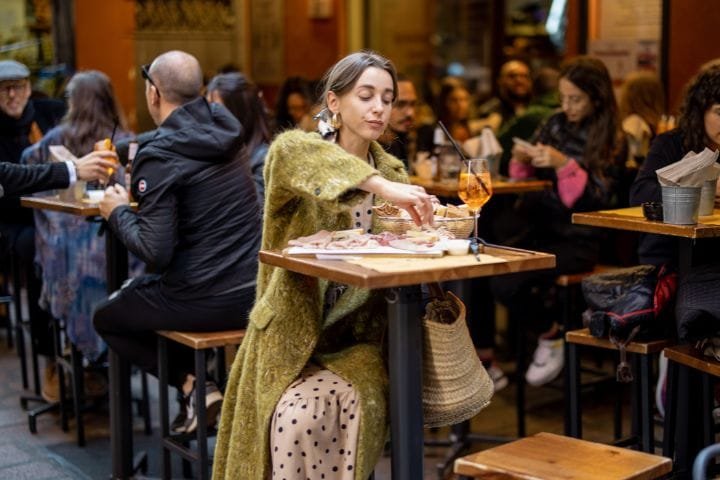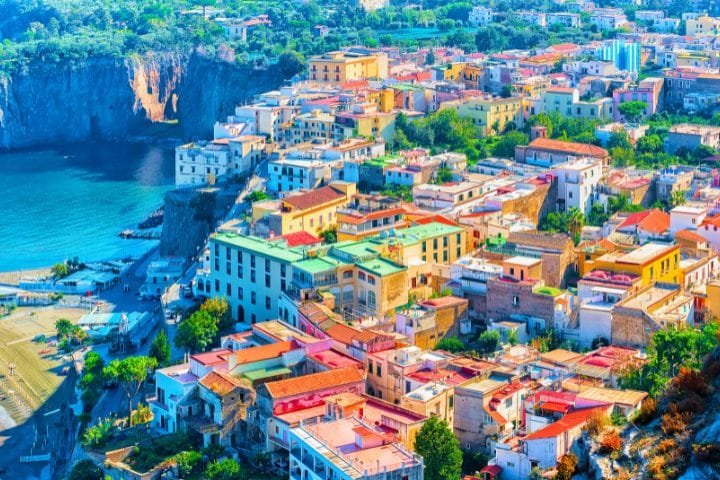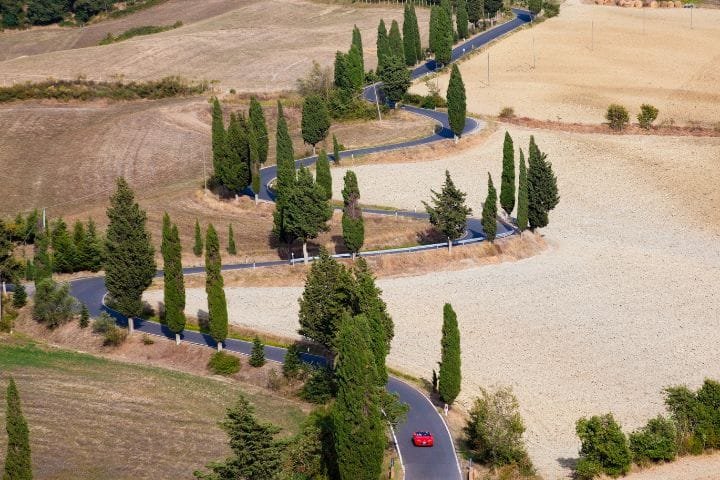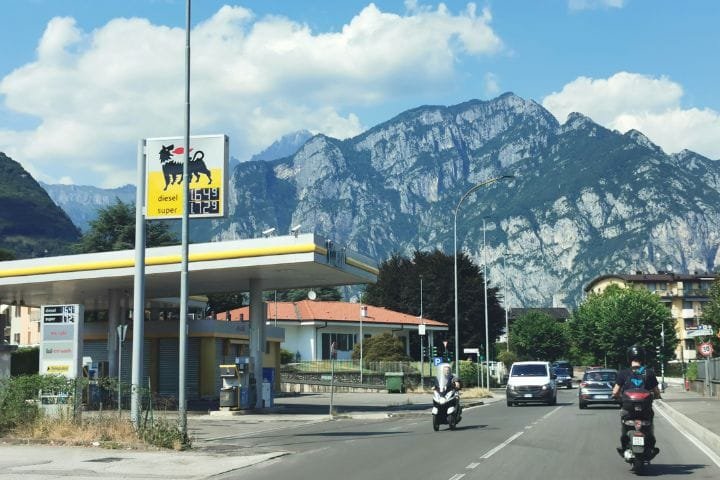The Best Bologna Food Tour: A Delicious Journey Through Italy’s Culinary Capital (2025)

by Asia A. | Last Updated December 10, 2025

Ciao! As a Milanese who has made countless weekend trips to Bologna over the past decade – initially drawn by the city’s legendary reputation as Italy’s culinary capital, then repeatedly returning for the incredible food experiences that never disappoint – I can tell you that Bologna offers some of the most authentic and delicious food tours in all of Italy. From the world-famous tortellini and ragù Bolognese to the incredible mortadella and Parmigiano-Reggiano aged in nearby caves, Bologna’s food scene combines centuries-old traditions with innovative contemporary interpretations that showcase why Emilia-Romagna is considered Italy’s true gastronomic heartland.
What makes Bologna food tours particularly special is how they connect you directly to family-run shops, historic markets, and traditional trattorias where recipes have been passed down through generations, creating authentic experiences that go far beyond simple restaurant visits to provide genuine insights into Italian food culture, production methods, and the passionate families who maintain these culinary traditions.
Let me share the insider knowledge I’ve gained from years of food exploration – The Best Bologna Food Tour that offers the most authentic experiences, where to find the best traditional products, and how to navigate this incredible food city like a local rather than a tourist!
Why Bologna Is Italy’s True Food Capital

Historical significance in Italian culinary development stems from Bologna’s position as a wealthy merchant city and major university center that attracted the best ingredients and most skilled cooks from across Italy. The combination of fertile Po Valley agriculture and sophisticated urban palates created conditions perfect for culinary innovation and refinement.
Bologna’s Alma Mater Studiorum, founded in 1088, is Europe’s oldest university, and centuries of feeding hungry students from across Italy created a diverse, dynamic food culture that welcomed influences while maintaining authentic local traditions.
Traditional dishes that originated here form the backbone of Italian cuisine worldwide, though often in bastardized versions that would horrify Bolognese nonnas. True ragù Bolognese, officially registered with Bologna’s Chamber of Commerce in 1982, bears little resemblance to the heavy, tomatoey “Bolognese sauce” served globally.
I’ll never forget watching the legendary Anna Maria Monti, former president of Bologna’s Accademia Italiana della Cucina, demonstrate proper ragù preparation. Her recipe, which takes over three hours and uses only a tablespoon of tomato paste, produces a silky, complex sauce that transforms simple tagliatelle into pure poetry.
Comparison with other Italian food cities reveals Bologna’s unique position. While Rome excels at simple, perfect preparations and Naples masters pizza and seafood, Bologna created the complex, layered cuisine that defines northern Italian cooking. Milan has innovation and sophistication, but Bologna has soul and tradition.
University city culture creates incredible diversity in dining options, from student-friendly osterias serving enormous portions at reasonable prices to sophisticated restaurants that attract food pilgrims from around the world. This academic atmosphere also fosters experimentation and cultural exchange while respecting traditional methods.
Protected designation origin products from Emilia-Romagna include some of Italy’s most prized ingredients: Parmigiano-Reggiano aged in nearby caves, authentic Modena balsamic vinegar, and mortadella di Bologna made according to centuries-old specifications.
Bologna’s culinary foundations:
- University city fostering culinary innovation and cultural exchange
- Po Valley location providing exceptional agricultural ingredients
- Wealthy merchant history supporting sophisticated food culture
- Official recipes and protected designations maintaining authenticity
- Central location attracting influences from across northern Italy
Best Guided Food Tours: Professional Experiences

Small group walking tours with expert local guides provide the most comprehensive Bologna food education, combining historical context with tastings at carefully selected traditional establishments. These tours typically limit groups to 8-12 people, ensuring personal attention and authentic experiences.
I’ve joined several of these tours over the years, and the best guides are often Bologna natives with deep family connections to local food traditions. They provide access to hidden shops and insider knowledge that independent exploration cannot match.
Luxury food tours focusing on premium experiences include private access to cheese aging facilities, exclusive tastings of aged balsamic vinegar, and meals at restaurants normally requiring weeks of advance reservations. These tours cost more but provide extraordinary access and education.
Last year, I splurged on a premium tour that included a private visit to a Parmigiano-Reggiano cave where wheels age for 36 months. Tasting cheese directly from cheese wheels was an unforgettable experience that justified the premium price.
Morning market tours with cooking class combinations begin in Bologna’s historic markets, where guides explain seasonal ingredients and traditional selection methods, then continue to professional kitchens for hands-on pasta making and sauce preparation.
Evening food tours with aperitivo and dinner experiences showcase Bologna’s vibrant nightlife and aperitivo culture, visiting multiple establishments for wine tastings, small plates, and the social rituals that define Italian evening dining.
Specialized tours focusing on specific elements like pasta making, cheese aging, or wine pairing provide deep dives into particular aspects of Bologna’s food culture. These tours appeal to serious food enthusiasts seeking comprehensive education rather than general overviews.
Professional tour advantages:
- Expert guides with deep local knowledge and family connections
- Access to exclusive locations and private experiences
- Small group sizes ensuring personal attention and authentic interactions
- Educational context explaining historical and cultural significance
- Carefully curated tastings at traditional establishments with proven quality
Get our FREE Italy
Travel Guide
E-Book
This printable guide is your ultimate companion for exploring Italy, with insider tips, detailed itineraries, transportation advice, must-see attractions, and more.

Bologna Self-Guided Food Tour Routes

Historic center food walk through Quadrilatero market district provides the classic Bologna food exploration, covering the medieval market area where specialty food shops have operated for centuries. This compact area allows easy walking while discovering incredible food diversity.
My typical self-guided route starts at Mercato di Mezzo around 10 AM, continues through the narrow medieval streets of Quadrilatero, and ends at a traditional osteria for lunch. This timing ensures optimal market activity and fresh product availability.
University area culinary exploration reveals student-oriented eateries that serve exceptional food at reasonable prices, plus wine bars and cafés that cater to international students seeking both familiar and adventurous flavors.
Local neighborhood discoveries beyond tourist areas require venturing into residential districts where families shop for daily meals. These areas offer authentic experiences without tourist markups, but require more Italian language skills and cultural sensitivity.
I discovered my favorite mortadella shop, Salumeria Bruno e Franco, in the San Donato neighborhood purely by accident when taking a wrong turn. The family has been making mortadella for four generations, and their pistachio variety is absolutely extraordinary.
Seasonal food tour routes adapt to ingredient availability and traditional preparations that change throughout the year. Spring tours might focus on fresh pasta with seasonal vegetables, while autumn emphasizes truffle dishes and hearty ragù preparations.
Weekend food market experiences take advantage of expanded market hours and special weekend vendors who bring products from throughout Emilia-Romagna. Saturday mornings offer the most variety and vibrant market atmosphere.
Self-guided exploration benefits:
- Flexible timing allowing spontaneous discoveries and extended stops
- Lower costs compared to professional guided experiences
- Authentic interactions with local vendors and restaurant owners
- Ability to revisit favorite discoveries and build ongoing relationships
- Personal pace accommodating individual interests and dietary preferences
🚗 Craving More Adventures Around Bologna?
If Bologna sparked your appetite for Italian road trips, check out these epic drives packed with local eats, scenic routes, and hidden gems:
👉 Northern Italy Road Trip – from the Alps to Emilia-Romagna, it’s pasta and panoramas all the way
👉 Italy’s Ultimate Food Road Trip – chase bold flavors across regions, from Bologna to Naples
👉 Italy’s Hidden Gems Road Trip – tiny villages, secret restaurants, and places the tour buses miss
Traditional Food Markets and Historic Shops

Mercato di Mezzo represents Bologna’s heart as a historic covered market dating to medieval times, where vendors maintain family businesses passed down through generations. The market’s compact size allows efficient exploration while offering incredible product diversity.
The cheese vendor here, where I’ve been shopping for years, knows my preferences and always offers tastes of new arrivals or seasonal specialties. This personal relationship transforms market shopping from a transaction to a cultural experience.
Quadrilatero district contains centuries-old specialty shops occupying medieval buildings along narrow cobblestone streets. Each shop specializes in specific products with knowledge and quality that modern supermarkets cannot match.
Tamburini, founded in 1932, remains my go-to stop for exceptional cured meats and aged cheeses. The current generation maintains traditional selection standards while introducing customers to rare regional specialties that most tourists never encounter.
Family-run delis and salumerie provide authentic products made according to traditional methods, often by families who have perfected their recipes over generations. These shops offer tastings, preparation advice, and stories behind their products.
Traditional pasta shops where tortellini is made fresh daily showcase the incredible skill required for proper pasta preparation. Watching experienced pasta makers fold hundreds of tortellini per hour demonstrates artistry that machine production cannot replicate.
Atti, established in 1868, continues making pasta by hand using traditional methods and local ingredients. Their tortellini, made fresh every morning, represents the gold standard that all others are measured against.
Historic bakeries maintain regional specialties and traditional baking methods that create unique flavors and textures impossible to achieve with modern industrial techniques.
Traditional market and shop highlights:
- Mercato di Mezzo: Historic covered market with multigenerational vendors
- Quadrilatero district: Medieval streets lined with specialized food shops
- Family salumerie offering traditional cured meats and aged cheeses
- Fresh pasta shops demonstrating traditional hand-making techniques
- Historic bakeries maintaining regional specialties and traditional methods
Must-Try Bologna Specialties and Where to Find Them

Tortellini en brodo represents Bologna’s most iconic dish when prepared properly with delicate pasta parcels floating in rich, clear broth made from multiple meats and aged Parmigiano-Reggiano. Authentic tortellini are tiny – traditionally seven rings per spoonful – and contain filling made from prosciutto, mortadella, and Parmigiano-Reggiano.
For the most authentic experience, I recommend Osteria del Sole, where you bring your own food but can order their exceptional broth. Alternatively, Trattoria Anna Maria serves tortellini that rival homemade quality in a traditional setting that hasn’t changed in decades.
Ragù Bolognese, when prepared authentically, creates a complex sauce that transforms simple pasta into extraordinary cuisine. True ragù requires hours of patient cooking and contains no garlic, herbs, or excessive tomato – just meat, wine, milk, and time.
All’Osteria Bottega serves ragù that follows the official Bologna Chamber of Commerce recipe, ladled over fresh tagliatelle made in-house. Their version requires four hours of cooking and produces the silky, complex sauce that made this dish famous worldwide.
Mortadella di Bologna in premium varieties showcases how this traditional salume can achieve extraordinary complexity and refinement when made properly with high-quality ingredients and traditional methods.
Salumificio San Carlo produces mortadella with pistachios that melts on your tongue while delivering complex flavors impossible to achieve with industrial production. Their products are available at select delis throughout the Quadrilatero.
Parmigiano-Reggiano aging experiences provide education about how this king of cheese develops flavor complexity through controlled aging in traditional caves. Tasting wheels of different ages reveals how time transforms simple ingredients into extraordinary complexity.
Caseificio San Lucio, just outside Bologna, offers tours of their aging facilities where you can taste Parmigiano-Reggiano at 12, 24, and 36 months while learning about traditional production methods that have remained unchanged for centuries.
Local wines complement regional cuisine with varieties like Lambrusco that provide effervescence and acidity perfect for cutting rich mortadella and aged cheeses, while Sangiovese di Romagna offers structure and complexity for heartier dishes.
Get our FREE Italy
Travel Guide
E-Book
This printable guide is your ultimate companion for exploring Italy, with insider tips, detailed itineraries, transportation advice, must-see attractions, and more.

Essential Bologna specialty experiences:
- Authentic tortellini en brodo at traditional osterias
- Proper ragù Bolognese following official registered recipes
- Premium mortadella varieties from artisanal producers
- Parmigiano-Reggiano cave visits and multi-age tastings
- Regional wine pairings showcasing Emilia-Romagna varieties
Cooking Classes and Hands-On Experiences

Traditional pasta-making workshops provide hands-on education in techniques that require years to master properly. Learning proper tortellini folding from experienced instructors reveals the incredible skill and precision required for authentic preparation.
I’ve taken several pasta classes in Bologna, and the best instructors are often nonnas who learned from their mothers and grandmothers. Their patience and gentle correction help students understand why certain techniques produce superior results.
Ragù preparation classes teach the patience and technique required for authentic sauce preparation, including proper ingredient ratios, cooking temperatures, and timing that create the complex flavors that made this sauce internationally famous.
Cook Italy offers exceptional ragù classes where you learn not just recipes but the principles behind ingredient selection, cooking sequence, and timing that allow home cooks to recreate authentic results in their own kitchens.
Market-to-table experiences combine ingredient selection education with cooking instruction, teaching how traditional Italian cooks evaluate seasonal quality and adapt recipes based on available ingredients.
Cheese and charcuterie workshops with expert producers provide education about traditional production methods, aging processes, and quality evaluation that help participants become more sophisticated consumers and appreciators.
Wine tasting classes focusing on Emilia-Romagna varieties teach food pairing principles while exploring lesser-known regional wines that complement local cuisine better than more famous Italian varieties.
Hands-on learning advantages:
- Traditional techniques taught by experienced local instructors
- Understanding of principles allowing successful home recreation
- Market education about ingredient selection and quality evaluation
- Cultural context explaining historical and family traditions
- Personal skills development creating lasting value beyond tourism
Budget-Friendly Food Experiences

Street food and casual dining in Bologna offers exceptional quality at student-friendly prices, with university-area establishments serving generous portions of authentic dishes without tourist markups.
My favorite budget discovery is Da Bertino, a tiny place near the university where they serve enormous plates of tortellini for under €8. The quality rivals expensive restaurants, but the atmosphere is purely local students and professors.
Student-oriented eateries throughout the university district provide authentic experiences where you eat alongside local students while enjoying traditional dishes prepared with care, despite low prices.
Happy hour aperitivo traditions offer exceptional value, with many establishments providing substantial food spreads included with drink purchases. This tradition allows sampling multiple specialties while socializing in authentic local settings.
Osteria del Sole, Bologna’s oldest osteria, allows you to bring your own food while providing wine and atmosphere in a historic setting that has welcomed students and locals for centuries.
Local markets for self-catering provide access to premium ingredients at wholesale prices, allowing budget travelers to create exceptional meals using the same products served in expensive restaurants.
Free food experiences include market browsing, seasonal festivals, and cultural events that provide food education and tastings without direct costs.
Budget-friendly strategies:
- University district dining with authentic quality at student prices
- Aperitivo traditions providing substantial food with drink purchases
- Market shopping for premium ingredients at wholesale prices
- Free cultural events and festivals offering food education
- BYOB establishments providing atmosphere and wine service
Food Tour Planning and Practical Tips
Best times for optimal food experiences vary by season and day of week, with weekday mornings offering the most active markets and freshest products, while evenings provide vibrant aperitivo culture and social dining experiences.
I prefer visiting Bologna Thursday through Saturday when markets are most active and restaurants have their full menus available. Tuesday and Wednesday can be challenging because many traditional establishments close.
Booking strategies for popular experiences require advance planning for renowned restaurants and cooking classes, especially during peak tourist seasons and university events that bring additional visitors to the city.
Dietary restrictions and food allergies can be accommodated at most establishments, but require clear communication and advance notice. Bologna’s food culture emphasizes fresh, high-quality ingredients that often work well for various dietary needs.
Transportation from Milan takes just over an hour by high-speed train, making Bologna perfect for day trips or weekend food adventures. The train station is within walking distance of the historic center and food districts.
Budget planning for different tour types should account for significant price variations between casual market browsing and luxury guided experiences, with most authentic experiences falling in moderate price ranges.
Planning recommendations:
- Thursday-Saturday visits for optimal market activity and restaurant availability
- Advance reservations for popular restaurants and cooking classes
- Clear dietary communication and advance notice for restrictions
- High-speed train transportation from major Italian cities
- Flexible budgeting accommodating various experience levels and interests
🧳 Turning Your Bologna Food Tour Into a Full Italian Adventure?
If you’re planning beyond just a day of eating (no judgment if you’re not :)), these handy guides will help you map out the rest — and avoid driving mistakes like getting fined in a ZTL zone!
👉 🚗 How to Plan the Perfect Italy Road Trip – routes, timing, and what not to miss (yep, Bologna’s in there!)
👉 🔑 Car Rental Tips for Italy – avoid the common mistakes and hit the road stress-free
👉 📅 Two-Week Italy Road Trip Itinerary – from the Alps to the coast, with plenty of food stops in between
👉 🚫 ZTL Zones in Italy: Complete Driving Guide for Tourists – what they are, how to avoid fines, and where to park safely
Discovering Bologna’s Culinary Soul
Bologna’s food tours provide unparalleled access to authentic Italian culinary traditions, premium regional products, and the passionate food artisans who maintain centuries-old recipes and production methods that define true Italian gastronomy.
Whether you choose professional guided experiences that provide expert insights and exclusive access, self-guided explorations that allow flexible discovery of hidden gems, or hands-on cooking classes that teach traditional techniques, Bologna rewards food lovers with genuine culinary adventures that showcase why this city earned its reputation as Italy’s undisputed food capital.
As someone who regularly makes the short journey from Milano to experience Bologna’s incredible food scene, I can assure you that investing time in proper food tours here provides culinary education, authentic cultural experiences, and delicious memories that enhance your appreciation for Italian cuisine long after returning home.
The combination of historic food markets, family-run specialty shops, traditional trattorias, and innovative contemporary interpretations creates food tour experiences that satisfy both casual food enthusiasts and serious culinary students seeking a deep understanding of Italian gastronomic heritage and continuing traditions.
That’s the real magic of Bologna food tours – they connect you not just to incredible flavors, but to the people, traditions, and cultural values that make Italian cuisine the beloved global phenomenon it has become.
FAQs About Bologna Food Tours
What is a Bologna food tour like?
A Bologna food tour typically includes visits to local markets, traditional eateries, and tasting sessions of iconic dishes like tortellini, mortadella, and ragù.
How long does a typical Bologna food tour last?
Most food tours last between 2 to 4 hours, giving you enough time to taste multiple dishes and explore different food spots.
What are the must-try dishes on a Bologna food tour?
Don’t miss tagliatelle al ragù (Bolognese sauce), tortellini, mortadella, crescentine (fried bread), and Parmigiano-Reggiano cheese.
Are Bologna food tours suitable for vegetarians?
Yes! Many tours offer vegetarian-friendly options or can customize the experience upon request.
How much does a Bologna food tour typically cost?
Prices vary, but most guided food tours range from €50 to €130 per person, depending on the length and inclusions.
Do I need to book Bologna food tours in advance?
It’s better to book in advance, especially during peak seasons, to secure your spot and your preferred time.
Can children join Bologna food tours?
Many tours welcome children, but it’s best to check with the tour provider for age restrictions or family-friendly options.
Get our FREE Italy
Travel Guide
E-Book
This printable guide is your ultimate companion for exploring Italy, with insider tips, detailed itineraries, transportation advice, must-see attractions, and more.

💬 We’d love to hear from you!
Have questions, tips, or personal travel stories to share? Drop them in the comments below — your insights help fellow travelers plan their adventures too.










